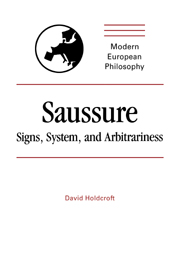Book contents
- Frontmatter
- Contents
- Preface
- Introduction
- 1 Saussure's work: its context and significance
- 2 The distinction between langue and parole
- 3 Language as a system of signs, I: Signs, arbitrariness, linearity, and change
- 4 Language as a system of signs, II: Diachronic and synchronic linguistics
- 5 Language as a system of signs, III: Identities, system, and relations
- 6 Language as a system of signs, IV: Values, differences, and reality
- 7 Successes and failures
- Notes
- Bibliography
- Index
3 - Language as a system of signs, I: Signs, arbitrariness, linearity, and change
Published online by Cambridge University Press: 11 January 2010
- Frontmatter
- Contents
- Preface
- Introduction
- 1 Saussure's work: its context and significance
- 2 The distinction between langue and parole
- 3 Language as a system of signs, I: Signs, arbitrariness, linearity, and change
- 4 Language as a system of signs, II: Diachronic and synchronic linguistics
- 5 Language as a system of signs, III: Identities, system, and relations
- 6 Language as a system of signs, IV: Values, differences, and reality
- 7 Successes and failures
- Notes
- Bibliography
- Index
Summary
The title ‘Language as a System of Signs’ was proposed by Saussure himself for Part 1, Chapter 1, of CLG, but for some reason the editors ignored his suggestion. I have used it as part of my title because it encapsulates a central point in Saussure's theory, namely that a language (langue) is a system of signs forming a well-defined object which can be studied independently of the other aspects of natural language. Thus, as was argued in the preceding chapter, the ideas in this and later chapters of CLG can be seen as deepening the characterisation of langue developed so far. As we shall see, there are many occasions on which Saussure returns to points raised earlier.
Clearly, there are two central ideas to be introduced now, that of a sign and that of a system. To develop the former, Saussure introduces two key principles, the Arbitrary Nature of the Sign and the Linear Nature of the Signifier. The first of these has been the object of a great deal of discussion; the second has occasioned much less comment despite Saussure's claim that it is as important. As we shall see, each principle has a major role to play in Saussure's overall argument. However, the characterisation of them in Part 1, Chapter 1, is only partial, and Saussure expands it in a number of important ways in later chapters.
- Type
- Chapter
- Information
- SaussureSigns, System and Arbitrariness, pp. 47 - 68Publisher: Cambridge University PressPrint publication year: 1991



